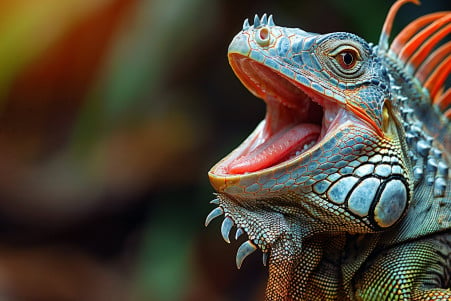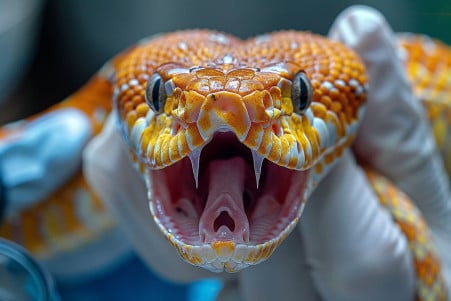Axolotl Teeth: What You Need to Know About Their Special Dentition
5 March 2024 • Updated 4 March 2024

One of the many unique things about axolotls is their teeth. That’s right, axolotls have small, cone-shaped teeth on both their upper and lower jaws. However, these teeth aren’t used for chewing. Instead, they help the axolotl grab its prey, which it then swallows whole. And don’t worry, their bite doesn’t hurt.
In the sections below, we’ll explore biological and evolutionary studies that have uncovered the details of axolotl dentition. This will cover everything from research in zoology that has looked at their eating habits to genetics studies that have focused on their ability to regenerate.
We’ll also look at the sensory biology that supports their predatory behavior. This will all come together to give you a better idea of these special amphibians and their unassuming teeth.
Do axolotls have teeth?
Axolotl Teeth: A Specialized Structure for Suction Feeding
According to A-Z Animals, axolotl teeth are small, cone-shaped, and are found in both the upper and lower jaws, with 30–40 teeth in each row. These teeth are not used for chewing, but instead are perfectly adapted for suction feeding, and are essential to the axolotls’ feeding behavior. As Axolotl Nerd describes, axolotls use their mouths to create suction that pulls in water and prey, a behavior called cup-mouth feeding.
Because the teeth are not adapted for chewing, axolotls swallow their prey whole, which is consistent with the small crustaceans, insects, and worms that they eat in the wild. The fact that the teeth are vestigial, a remnant of the axolotl’s ancestors’ more functional teeth, means that they are still useful for helping axolotls catch and hold their prey as they quickly suck it in during their unique feeding behavior.
While axolotls do have teeth, they are not a threat to people. Because they are adapted to the axolotls’ feeding behavior, the teeth are not sharp enough to break human skin, and bites from axolotls typically only result in small indentations. This is another example of the axolotls’ specialized adaptations and is also a sign of the amazing regenerative abilities that are another reason axolotl teeth can be seen as a functional adaptation.
Axolotl Teeth and Their Regenerative Potential
In addition to their unusual dental anatomy, axolotls are also known for their ability to regenerate dental tissue. This ability demonstrates a level of biological sophistication that goes beyond basic wound healing, and the fact that axolotls can regenerate their teeth is a prime example of this.
In an article in Developmental Dynamics, researchers describe how axolotls regenerate their teeth in a process that begins at the base and moves toward the crown, a level of complexity that has the potential to change regenerative medicine.
Axolotls show the same level of complexity in their ability to regenerate other dental structures, which they do without scarring. As a result, researchers in PMC have suggested that the same signaling pathways that are involved in tooth regeneration may also be involved in the regeneration of other tissues, including limbs, hearts, and spinal tissues.
The potential applications of this research are far-reaching, especially when it comes to the challenges that humans face in dental repair and therapy. The knowledge gained from axolotl tooth regeneration has the potential to lead to new therapies that can stimulate tissue regeneration in the human orofacial region, where current therapies are limited, according to PubMed.
The complexity of the signaling pathways and growth factors involved in axolotl tooth regeneration could lead to new discoveries in dental science and the development of regenerative therapies that could be used to improve human health in the future.
What Do Axolotls Eat? From Wild Prey to Captive Diet
In the wild, axolotls are opportunistic hunters, and they primarily eat small fish, crustaceans, and worms. They use their small, pointed teeth to grab their prey, but not to chew it.
This carnivorous diet is reflected in captivity, where axolotls are usually fed a diet of commercial pellets, bloodworms, and lean meats, according to a study in Zoo Biology. A study in Agro Productividad determined that a 45% protein diet is best for juvenile axolotls, which is similar to the high-protein diet they eat in the wild.
When axolotls eat, they open their mouths quickly and use their teeth to grab their prey, but only for a split second, to ensure that their prey is sucked into their mouths.
This shows how well their teeth have evolved to help them eat a variety of prey.
As a result, the dietary habits of axolotls have influenced the evolution of their teeth, which are perfectly adapted to help them eat a variety of prey in the wild and in captivity.
As scientists learn more about axolotls, it’s clear that their teeth are just one of many factors that have helped them thrive in their environment.
The Evolutionary History of Axolotl Teeth
The evolutionary history of axolotl teeth provides a fascinating look into the past and the ways in which adaptation has shaped the present. Work by Vladimir Soukup has demonstrated that the distribution and development of axolotl teeth follow a pattern that is consistent with other vertebrates. This common epithelial origin suggests that axolotls share an evolutionary history with other tetrapods.
Meanwhile, the organization of the axolotl’s dentition, which consists of five pairs of tooth fields that form two separate dental arcades, is consistent with the organization found in other amphibians, as demonstrated by Ivan Horacek.
Looking at the genetic level, research has shown that the first teeth of axolotls develop at the ecto-endodermal boundary, which suggests that the development of their teeth is the result of a complex interaction between different germ layers.
An article by Vladimir Soukup on PubMed explains that the development of oral teeth in axolotls results from the convergence of ectodermal and endodermal origins, which underscores the complex evolutionary pressures that have likely impacted the dental structure of axolotls.
The survival and adaptation of axolotls is closely tied to their teeth, which allow them to feed effectively in their aquatic environment. As a result, the evolution of axolotl teeth has led to a set of dental tools that have been fine-tuned to create an anatomy that is specialized and optimized for their predatory way of life.
Understanding the genetic and developmental history of axolotl teeth helps to inform our understanding of their unique biology and highlights the larger evolutionary story of vertebrate dentition.
Axolotls’ Taste for Prey: Sensory Biology in Feeding
Axolotls’ predatory behavior is closely tied to their sensory biology, especially their taste and smell systems. With around 1,400 taste buds located on the lingual surfaces of their jaws, as described in a paper by Kenneth C. Catania, axolotls have a highly developed gustatory system. Each taste bud is a complex organ made up of 50 to 80 cells, making it exquisitely sensitive to the presence of prey molecules in the water.
This sensitivity is further supported by their olfactory system, which, while not as well-studied as their gustatory system, is still an important part of prey detection. These two systems work together to help axolotls locate their prey, at which point their teeth take over.
Behavioral research has shown that axolotls use their highly sensitive taste and smell systems to find and capture prey, and then use their teeth to hold the prey in place while they suction feed.
The coordination between their taste buds, olfactory system, and teeth is a marvel of biological engineering that helps them succeed as underwater predators. An axolotl oropharyngeal explants transcriptome analysis by Lauren Marazzi demonstrates the genetic basis of taste bud development, which helps explain the evolution and role of these sensory systems in concert with their teeth.
This sensory–dental coordination is crucial for their survival, and it illustrates another aspect of the complex axolotl biology that makes them so fascinating to researchers and enthusiasts alike.
Unraveling the Genetic Mysteries of Axolotl Tooth Regeneration
The genetic details of axolotl tooth development provide important clues to the animal’s regenerative powers. A study in PMC notes that genes like Shh and Sp7 are important for tooth development and regeneration. These genes help odontoblasts differentiate and also help signal the invagination of dental epithelium, which is the first step in tooth development.
Comparative studies have found that axolotls and other vertebrates have a conserved gene set, which means that there are similar genetic blueprints for regenerative processes. For example, a study in EvoDevo has found that there is a group of genes that are expressed in both zebrafish and stickleback fish during tooth regeneration, which suggests that there is a universal ‘successional dental epithelium’ that works across species with different teeth.
These genetic findings have important implications for regenerative medicine. By understanding the genetics behind axolotl tooth regeneration, researchers may be able to find new ways to repair human tissues and organs. As more is learned about the genetics of axolotl tooth development, the idea of using these regenerative powers in humans becomes more realistic, bringing together the best of nature and science.
The Strange Evolutionary Path of Axolotl Teeth
To wrap up our discussion of axolotl teeth, we’ve come to a fascinating biological story. These amazing animals have small, cone-shaped teeth that are used for grasping prey, not chewing, according to Axolotl Nerd. Their “cup-mouth” feeding behavior, where they suck in their food, is a clear example of how they evolved from their salamander ancestors, who had teeth that were much more robust and used for tearing.
The regenerative properties of axolotl teeth are especially exciting to researchers. As a Scientific Reports article explains, the process is controlled by a number of factors, including nerves and signaling molecules like Fgf and Bmp, and could have important implications for regenerative medicine and dentistry.
Their teeth, which are now considered vestigial, have been important in their ability to adapt and thrive in their environment, according to A-Z Animals, and the fact that they continue to grow new teeth throughout their lives is a compelling demonstration of the power of nature and a potential source of hope for future medical treatments in humans.
In the end, axolotl teeth are more than just teeth; they are a sign of evolution and a sign of nature’s creativity and potential to change the world, including the world of medicine.


